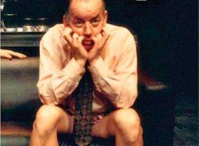This summer, I’ve set myself a goal to read a new play every week. In particular, I’m reading a new Canadian play every week. And I’m hoping to get more done than that. Our country has a great, albeit short, history of creating and publishing new work, producing it once or twice, and then leaving it on a shelf. While I’m not in a position to change the last part of that, I think I have a responsibility (as a Canadian theatre artist) to understand more about the work that came before.
First on my list was a re-read of Maggie and Pierre. I’ve always loved this piece, and I wanted to recapture that love for it to kick off this mini-exploration of our culture. There are few pieces as “Canadian” in character, and few playwrights as provocative as the incomparable Linda Griffiths. I followed that up with Michael Healey’s Plan B. Another distinctively Canadian piece, one that started me thinking about how National (with a capital N) some of our past work is, and how rarely that same National spirit is reflected in the new work of today. So when I started writing this post, I thought that I was going to write about how we don’t write about Canada anymore.
But then I realized that my question wasn’t really about the content of what was in these plays, but rather the conceit or the jumping off point for them in the first place. Both pieces deal with issues of Canadian politics—yes—but both also explore an imagined reality. And this is the thing I wanted to write about.
In Plan B, as is the case with much of Healey’s work, he imagines a particular version of Canada. This isn’t a “real” Canada per se but it is close enough that we know it could be real. In Plan B, the action centres around the negotiation of the separation of Quebec from Canada. In Maggie and Pierre, Griffiths is exploring real situations and real characters, but the reality of those characters in those situations (what they say and what they do) is highly poetic, and highly imagined. Healey’s Proud is another great example of this kind of imagined reality, and given how recently it was produced, it will likely render my question erroneous. I should be clear that none of this is a criticism—quite the opposite, in fact.
My last 10 years in professional theatre has proved a consistency of fads in our community. We all want to be multidisciplinary, so we all are. Then we want to be site-specific, so we all are. Then we all want work to be verbatim, so we make verbatim work. Following trends, of course, is a symptom of art-making, and ultimately of stealing great ideas from one another to make them even greater. And again, this is not a criticism. Stemming from docu-drama and verbatim work, we have found a current interest in “theatre of the real.” This focus has led to a series of pieces featuring non-professional performers, or professional performers in some sort of “non-performance” in order to put a real mirror up to real society, and show people who are truly never seen on stage. I myself have developed work like this in the past and will likely continue to do so. Some of my favourite work over the last few years has been created in this way. One need not look far to find an example of “theatre of the real” in Canada. In fact, Queen’s University professor Jenn Stephenson is currently researching this very movement.
But in this age of exploring (and occasionally exploiting) the “real,” are we missing out on the opportunity to create these imagined realities? It’s an honest question, because I don’t have an answer. Yet, as I make my way through these works of Canadian artists over the past 40 years, I feel a sense of nostalgia for this work, despite being young (or non-existent) when some of it was written. We live in an age of self-selection, of “reality” television, and youtube channels that are overtaking network television. This age promotes work that is boundary-pushing, and provocative, and innovative, and technological. But also real. The theatre is always a place for real connection between performer and observer, no matter what other elements might be applied. I guess I wonder if in applying all of these elements, these trends, we might be suppressing our appetite for the imagined?

